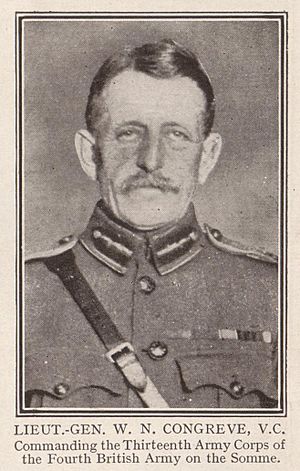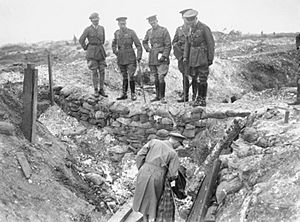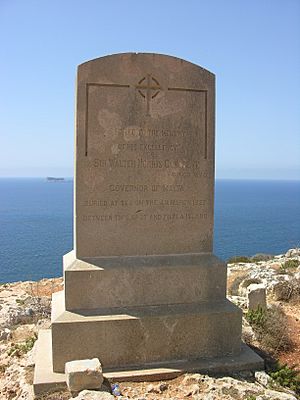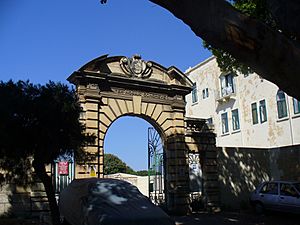Walter Congreve facts for kids
Quick facts for kids
Sir Walter Congreve
|
|
|---|---|
 |
|
| Born | 20 November 1862 Chatham, Kent, England |
| Died | 28 February 1927 (aged 64) Mtarfa Hospital, Malta |
| Buried |
Buried at sea between Malta and the Island of Filfla
|
| Allegiance | United Kingdom |
| Service/ |
British Army |
| Years of service | 1885–1924 |
| Rank | General |
| Unit | Rifle Brigade |
| Commands held | Southern Command (1923–24) British Troops in Egypt (1919–23) VII Corps (1918) XIII Corps (1915–18) 6th Division (1915) 18th Brigade (1914–15) |
| Battles/wars | Second Boer War First World War |
| Awards | Victoria Cross Knight Commander of the Order of the Bath Member of the Royal Victorian Order Mentioned in Despatches |
| Relations | Major Billy Congreve (son) Cecil Ralph Townshend Congreve (Brother) |
| Other work | Deputy Lieutenant of Staffordshire Governor of Malta (1924–27) |
General Sir Walter Norris Congreve (born November 20, 1862 – died February 28, 1927) was a brave British Army officer. He fought in two major wars: the Second Boer War and the First World War. Later, he became the Governor of Malta from 1924 to 1927. He earned the Victoria Cross, which is the highest award for bravery in the face of the enemy for British and Commonwealth soldiers.
Contents
Early Life and Education
Walter Norris Congreve was born in Chatham, Kent, England. His parents were William and Fanny E. Congreve. He went to Twyford School and Harrow School. Later, he studied at Pembroke College, Oxford.
Joining the Army
Walter Congreve started his army career in the Rifle Brigade. He became a lieutenant in 1885. By 1893, he was promoted to captain.
Fighting in the Second Boer War
The Second Boer War began in October 1899 in South Africa. Captain Congreve joined the British forces there. He was part of the group trying to help the city of Ladysmith. This city was under attack by the Boers.
Bravery at Colenso
On December 15, 1899, a big battle happened at Colenso. British soldiers tried to cross the Tugela River. But the Boers stopped them, causing a major defeat. During this battle, Captain Congreve showed incredible bravery.
Many soldiers who were firing the big guns (artillery) were hurt or had to leave their positions. The guns were left alone. Captain Congreve, along with two other officers and a corporal, went to save these guns. The area was very dangerous, with bullets and shells flying everywhere.
They managed to get two of the guns to safety. Even though Captain Congreve was wounded, he saw another officer fall. He went back into the dangerous area to help the wounded man. For his actions, he received the Victoria Cross.
At Colenso on the 15th December, 1899, the detachments serving the guns of the 14th and 66th Batteries, Royal Field Artillery, had all been either killed, wounded, or driven from their guns by Infantry fire at close range, and the guns were deserted. About 500 yards behind the guns was a donga in which some of the few horses and drivers left alive were sheltered. The intervening space was swept with shell and rifle fire. Captain Congreve, Rifle Brigade, who was in the donga, assisted to hook a team into a limber, went out; and assisted to limber up a gun. Being wounded, he took shelter; but, seeing Lieutenant Roberts fall, badly wounded, he went out again and brought him in. Captain Congreve was shot through the leg, through the toe of his boot, grazed on the elbow and the shoulder, and his horse shot in three places.
After Colenso
Captain Congreve was injured, so he missed the actual relief of Ladysmith. But he returned to duty later in 1900. He became a staff officer and helped organize troops. He was promoted to major in 1901. He also received a special promotion to lieutenant-colonel. This was to recognize his excellent service in South Africa.
Leadership in the United Kingdom
After the Boer War ended in 1902, Congreve returned to Britain. He held several important leadership jobs. In 1902, he became an Assistant Military Secretary in Ireland. He worked for the Duke of Connaught, a member of the Royal Family.
Service in the First World War


When the First World War started in August 1914, Congreve was a brigadier-general. He led the 18th Brigade. Even though he had asthma, he went with his troops to France. They were part of the British Expeditionary Force (BEF). He fought in the Battle of the Aisne.
The Christmas Truce
In December 1914, Congreve's men were near Neuve Chapelle. They took part in the famous Christmas truce. On Christmas Day, the German soldiers started calling for a truce. Some of Congreve's men went out to meet them in "no man's land." Soldiers from both sides exchanged gifts like cigars and cigarettes. Congreve himself chose not to go, fearing he might be a target for enemy snipers.
The Somme: Delville Wood
Congreve became the commander of the 6th Division in May 1915. Then, in November 1915, he led the XIII Corps. As commander of XIII Corps, he was in charge of battles like Longueval and Delville Wood. These battles happened between July and September 1916 during the Battle of the Somme.
His corps made quick progress in their part of the battle. This created a tricky situation where the battle lines were at a right angle. The goal was to "straighten the line" by taking Delville Wood. This area was on high ground, good for spotting enemy positions. Taking it would protect the British side and help the Allies advance. XIII Corps did secure Delville Wood. However, it was one of the bloodiest fights of the Somme. Both sides lost many soldiers. During the war, General Congreve lost one of his hands in action.
Later Life and Governor of Malta

After the First World War, Congreve continued his military career. He became a general and was knighted. He led the British forces in Egypt from 1919 to 1923. Then he was in charge of the Southern Command in the UK.
From 1924 until his death in 1927, he served as the governor of Malta. He died there in 1927. He had asked to be buried at sea. So, he was buried in the channel between Malta and Filfla Island. There is a small monument to him on the coast of Malta. The channel where he was buried is now known as Congreve Channel.
A school house at St. Edward's College in Malta is named after him. There is also a stone with his name above a gate in Floriana, Malta.
Family Life
Walter Congreve married Cecilia Henrietta Dolores Blount La Touche in 1890. Lady Congreve was a nurse during the First World War. She was also a poet and writer.
They had a son named Major Billy Congreve. Both Sir Walter and his son Billy won the Victoria Cross. They are one of only three father and son pairs to ever receive this highest award for bravery.
Victoria Cross Display
Sir Walter Congreve's Victoria Cross medal is on display. You can see it at the Royal Green Jackets (Rifles) Museum in Winchester, England.


